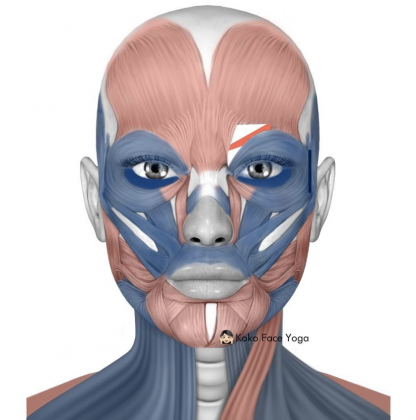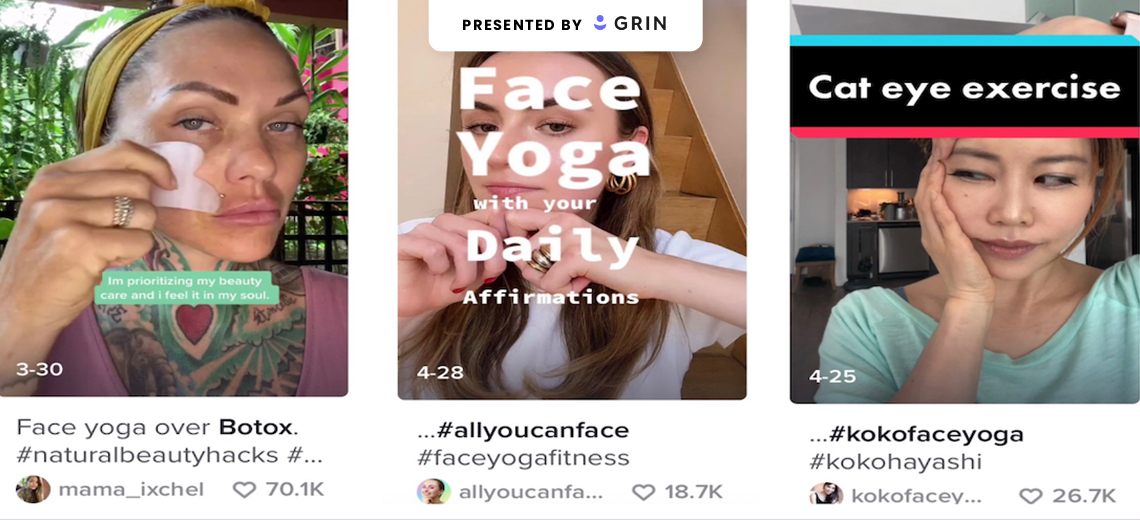All products featured on Glossy Pop are independently selected by our editorial team. However, when you buy something through our retail links, we may earn an affiliate commission.
Have you ever longed for a sharper jawline or cheekbones? Is the phrase “tongue posture” foreign to you? Do you have access to a smartphone? If you answered yes to these questions, you may want to watch this TikTok with 11.5 million views that was posted by Koko Hayashi, the Kardashians’ face yoga instructor and founder of Koko Face Yoga.
In the 13-second video, Hayashi (@kokofaceyoga on TikTok; 352,100 followers) demonstrates what the “correct tongue posture” for chiseled cheekbones looks like. (Spoiler: It should remain on the roof of your mouth.)
The #lipflip trend on TikTok highlights a new openness toward cosmetic procedures among Gen Zers and Millenials. However, that doesn’t negate the growing audience within the demographic for holistic practices like #faceyoga, which has amassed 351.1 million views on the platform since the start of 2020. Pinterest predicted “face yoga exercises” would be one of the top-five trending beauty terms on the platform this year.
“I started [using] TikTok because of the pandemic, and now [my following] is quickly growing,” said Hayashi. She owed the new interest to people’s focus on self-care. On kokofaceyoga.com, Hayashi likens face yoga to a “natural anti-aging facial.”
If Covid-19 is to #guasha on TikTok, then the Delta variant is to #faceyoga. In other words, both practices fall under the umbrella of ‘skinimalism’ and self-care, which took over the beauty space during the pandemic. And while the former holds seniority both in terms of its age and online popularity, the latter is quickly catching up to #guasha’s 613.7 million views on TikTok.
Despite its name, face yoga is not related to traditional yoga. “We use the name for SEO, but I personally like to call it face posture,” said Hayashi. She offers private face yoga sessions on her website, in addition to the free tutorials she posts on YouTube and TikTok.
Ad position: web_incontent_pos1
So rather than, say, contorting your tongue into a tree pose, face yoga involves facial postures and exercises, like the “forehead freeze.” In a tutorial on her YouTube channel, Hayashi demonstrates herself firmly placing her hands on her forehead while slowly looking up to “freeze” wrinkles and fine lines.
Like gua sha, which is rooted in traditional Chinese medicine, face yoga is a non-invasive path to the supposed destination of a contoured countenance and youthful skin. Face yoga has been popular in Japan for approximately two decades, said Hayashi, who moved from Japan to Los Angeles five years ago to teach face yoga. In contrast to gua sha — or a Botox-filled syringe — face yoga only requires your hands and a few minutes of your day, lending to its popularity on TikTok. According to Hayashi, who learned face yoga from Fumiko Takatsu, founder of The Face Yoga Method, face yoga focuses on two categories of muscles within the face: the “sleeping” (blue) and the “overworking” (red) muscles.
“We want to wake up [using facial exercises] the sleeping muscles to lift up the skin and relax the red, overworked muscles for wrinkle reduction,” she said. “The cheek areas or eye areas, those are blue,” while muscles around the forehead, nose and chin are “red.”

As for the results of the natural beauty hack, “You reduce wrinkles, you depuff your face, you sculpt your cheekbones, and you can work on facial asymmetries and overall improve your complexion,” said Anastasia Goron, founder of All You Can Face, an online facial yoga course. When you exercise your face, you enhance blood circulation and lymphatic drainage.” Goron’s program guides users through a daily “10-minute facial exercise routine,” she said.
Ad position: web_incontent_pos2
Before she discovered face yoga, Goron figured that she would get Botox at around 30 years old. But after attending a face yoga workshop in Berlin, “I thought, this topic is interesting, and no one in my age group, in their early 20s, knows about this,” she said. After noticing results in her skin, nose and facial asymmetry, Goron continued to practice face yoga and proceeded to launched All You Can Face in 2020.

Goron has amassed 6.2 million likes and almost 700,000 followers on TikTok, where she posts videos on “How to massage your face” (5.2 million views), “plump your lips” and give yourself an “eyelift.” Her TikTok titled “foxy eye massage” (57,500 views) plays into TikTok’s #foxeye trend (177.9 million views).
“When I show something on social media, it needs to be fast, quick and probably a little bit entertaining,” she said. However, Goron emphasized, “I’m all about enhancing what you already have and beautify who you are, rather than getting that nose from this celebrity or getting the cheekbones from this influencer.”
TikTok allows her to spread “awareness that you do not have to use plastic surgery or anything else to maintain your face,” she said. Her audience is mostly women ages 25-35, but she also sees 12-year-olds and 74-year-olds on the app, she said.
On the other hand, Hayashi, 42, turned to face yoga at age 27 following a “plastic surgery failure” of a chin implant. “[I] didn’t like it, so I had it removed,” she said. Hayashi was unsatisfied with the facial asymmetry that remained following the procedures and found a solution in face yoga, which worked to even out her chin.
Hayashi’s typical clientele ranges from those in their late twenties to forties, but on TikTok, “[the] audience is younger,” she said. Because of this, they’re more worried about having an asymmetrical face than they are about sagginess.
Chel Northcott is another proponent of face yoga on TikTok who switched from the needle to the knuckle. Northcott’s most-viewed TikTok is titled “I’ve replaced my botox with face yoga and gua sha;” it has 2.4 million views.
@mama_ixchelFace yoga over Botox. #naturalbeautyhacks #beautyroutines #ilovefaceyoga #byebyebotox #naturalskincareroutine♬ original sound – Babi
“For probably 10 years, I was doing [Botox] injections,” said Northcott. But after learning that Botox is tested on animals, she started to practice face yoga instead, about six months ago. “It creates a more youthful glow, working the fascia [to] stimulate your cell growth,” she said of face yoga. “I can be expressive in my face, and it moves, but I don’t have fine lines and wrinkles.”
Notably, Allergan, the maker of Botox and Juvederm, has been targeting younger customers through an increase in social media and influencer marketing since 2019. The company has also placed emphasis on preventative Botox to lure in younger millennials, like Northcott.
Northcott is also a fan of the aspect of self-care that is intrinsic to face yoga. “There’s something special about also connecting with myself, and giving myself that love and that attention that we forget about,” she said. Her morning and nightly facial massage rituals “connect me to my power of being a woman, and self-care is important for self-love.” On TikTok, #selflove has 21.6 billion views and #selfcare has 12.2 billion views.
Goron also incorporates the concepts of self-care and positive thinking into her face yoga videos, such as in her TikTok titled “Combine face yoga with your daily affirmations.”
“In the Western world, we are so much about quick fixes, like Botox,” said Goron. In contrast, “Eastern medicine is more about preventing and looking at everything as a holistic lifestyle from within yourself — from your thoughts, from what you eat, from how you behave.”
The desire for Eastern and holistic medicine has already made its way into the traditional beauty industry, with mushrooms and adaptogens taking over the space. Furthermore, the pandemic accelerated the spread of Eastern medicine-adjacent techniques like the gua sha and face yoga to the younger generation of consumers on TikTok — and backlash, as well. Some adopters of gua sha faced cultural appropriation allegations in 2020 for “modernizing” the ancient practice.
And while Hayashi and Goron’s digitized programs exemplify the current direction of the commercialization of face yoga, in the past, brands like Facegym set out to pioneer the physical studio aspect of the practice. Facegym, which launched its first standalone studio in January of 2019, shifted its course to “meet consumers at home” in 2021 by introducing virtual classes on Instagram, along with launching products to aid in the exercises. Meanwhile, celebrity facialist Isabel Bellis has offered the French massage technique effleurage in her services for decades.
Regarding the scientific basis of face yoga, in a study conducted by Murad Alam in 2018, the vice chairman of dermatology at Northwestern University determined that “a 30-minute daily or alternate-day facial exercise program sustained over 20 weeks may modestly improve the facial appearance of selected middle-aged women.”
“We [scientists] didn’t find any adverse effects [of face yoga], but all we can say is it had made people felt good about themselves,” said Dr. Sharad Paul, a New Zealand-based, world-renowned skin doctor. “Intermittently done, any form of general massage is probably good for you, [but] if you overdo it, it can stimulate some inflammation.”
But for those who may not be able to afford an anti-wrinkle serum, but still want a holistic, skin-deep solution — like the Gen Zers of TikTok — face yoga reigns on.
“You want to keep doing [face yoga] as long as you want to be beautiful,” said Hayashi. “Ideally, you should be doing it all the time.”




